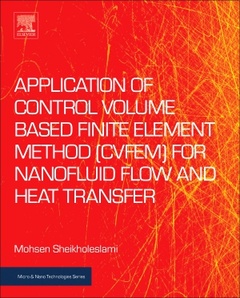Description
Application of Control Volume Based Finite Element Method (CVFEM) for Nanofluid Flow and Heat Transfer
Micro and Nano Technologies Series
Author: Sheikholeslami Mohsen
Language: English
Subject for Application of Control Volume Based Finite Element...:
Keywords
Advection-diffusion; Brownian; Brownian motion; Buongiorno model; CVFEM; Complex shaped cylinder; Convective heat transfer; Coulomb; Darcy model; Electric field; Electric field dependent viscosity; Electric field-dependent viscosity; Electrohydrodynamic; FHD; Ferrofluid; Ferrohydrodynamic; Force convection; Forced convection; Free convection; Grid; Heatline; Joule heating; KKL model; Lid driven cavity; Lorentz forces; MFD viscosity; MHD; Magnetic field; Magnetic source; Magnetohydrodynamic; Melting heat transfer; Mesh; Mixed convection; Nanofluid; Natural convection; Non-Darcy model; Porous media; Porous medium; Shape factor; Shape functions; Shape of nanoparticle; Shape of nanoparticles; Simulation; Single phase; Source term; Thermal nonequilibrium; Thermal radiation; Thermophoresis; Tilted enclosure; Unsteady; Vorticity stream function formulation
780 p. · 21.4x27.6 cm · Paperback
Description
/li>Contents
/li>Readership
/li>Biography
/li>Comment
/li>
Application of Control Volume Based Finite Element Method (CVFEM) for Nanofluid Flow and Heat Transfer discusses this powerful numerical method that uses the advantages of both finite volume and finite element methods for the simulation of multi-physics problems in complex geometries, along with its applications in heat transfer and nanofluid flow. The book applies these methods to solve various applications of nanofluid in heat transfer enhancement. Topics covered include magnetohydrodynamic flow, electrohydrodynamic flow and heat transfer, melting heat transfer, and nanofluid flow in porous media, all of which are demonstrated with case studies.
This is an important research reference that will help readers understand the principles and applications of this novel method for the analysis of nanofluid behavior in a range of external forces.
1. Detailed Explanation of Control Volume-based Finite Element Method2. Simulation of Vorticity Stream Function Formulation by Means of CVFEM 153. Various Application of Nanofluid for Heat Transfer Augmentation4. Single-phase Model for Nanofluid Free Convection Heat Transfer by Means of CVFEM5. Buongiorno Model for Nanofluid Treatment Using CVFEM6. Nanofluid Forced and Mixed Convection Heat Transfer by Means of CVFEM7. Effect of Uniform Lorentz Forces on Nanofluid Flow Using CVFEM8. Influence of Variable Lorentz Forces on Nanofluid Free Convection Using CVFEM9. Nanofluid Forced Convective Heat Transfer in Presence of Variable Magnetic Field Using CVFEM10. Influence of Shape Factor on Nanofluid Heat Transfer Improvement Using CVFEM11. Electrohydrodynamic Nanofluid Natural Convection Using CVFEM12. Forced Convection of Nanofluid in Existence of Electric Field Using CVFEM13. Darcy Model for Nanofluid Flow in a Porous Media by Means of CVFEM14. Non-Darcy Model for Nanofluid Hydrothermal Treatment in a Porous Medium Using CVFEM15. Thermal Nonequilibrium Model for Nanofluid Flow in a Porous Enclosure by Means of CVFEM16. Nonuniform Magnetic Field Effect on Nanofluid Convective Flow in a Porous Cavity17. Thermal Radiation Influence on Nanofluid Flow in a Porous Medium in the Presence of Coulomb Forces Using CVFEM18. Influence of Electric Field on Forced Convection of Nanofluid in a Porous Medium by Means of CVFEM19. Nanofluid Heat Transfer Enhancement in Presence of Melting Surface Using CVFEM20. Nanofluid Convective Heat Transfer Considering Magnetic Field Dependent (MFD) Viscosity by Means of CVFEM
Materials scientists, physicists, mathematicians and information scientists analyzing the performance of nanolfuid flow
Dr. Mohsen Sheikholeslami is the Head of the Renewable Energy Systems and Nanofluid Applications in Heat Transfer Laboratory at the Babol Noshirvani University of Technology, in Iran. He was the first scientist to develop a novel numerical method (CVFEM) in the field of heat transfer and published a book based on this work, entitled "Application of Control Volume Based Finite Element Method (CVFEM) for Nanofluid Flow and Heat Transfer". He was selected as a Web of Science Highly Cited Researcher (Top 0.01%) by Clarivate Analytics, and he was ranked first in the field of mechanical engineering and transport globally (2020-2021) according to data published by Elsevier. Dr. Sheikholeslami has authored a number of books and is a member of the Editorial Boards of the ‘International Journal of Heat and Technology’ and ‘Recent Patents on Nanotechnology’.
- Explains governing equations for nanofluid as working fluid
- Includes several CVFEM codes for use in nanofluid flow analysis
- Shows how external forces such as electric fields and magnetic field effects nanofluid flow




